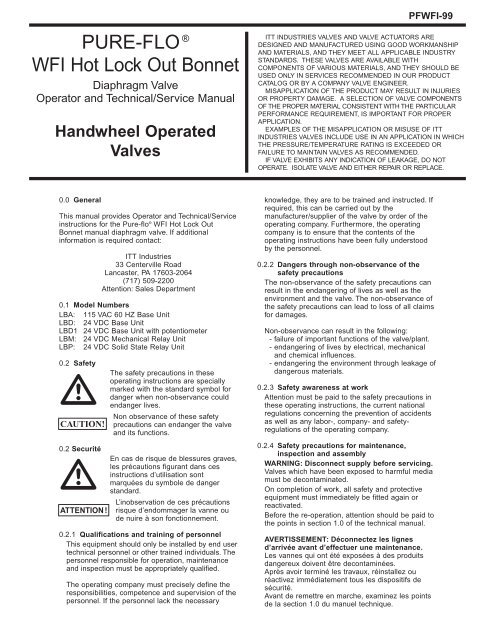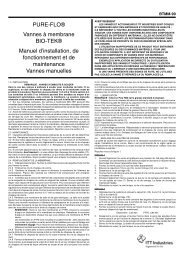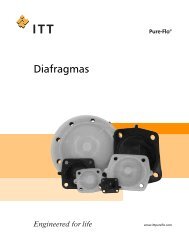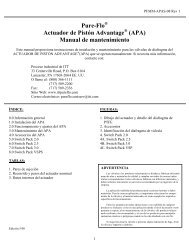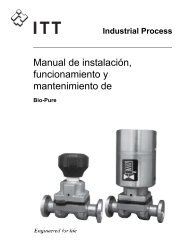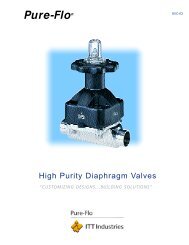PFMM-WFI-99 - Pure-Flo
PFMM-WFI-99 - Pure-Flo
PFMM-WFI-99 - Pure-Flo
Create successful ePaper yourself
Turn your PDF publications into a flip-book with our unique Google optimized e-Paper software.
PURE-FLO ®<br />
<strong>WFI</strong> Hot Lock Out Bonnet<br />
Diaphragm Valve<br />
Operator and Technical/Service Manual<br />
Handwheel Operated<br />
Valves<br />
0.0 General<br />
This manual provides Operator and Technical/Service<br />
instructions for the <strong>Pure</strong>-flo ® <strong>WFI</strong> Hot Lock Out<br />
Bonnet manual diaphragm valve. If additional<br />
information is required contact:<br />
ITT Industries<br />
33 Centerville Road<br />
Lancaster, PA 17603-2064<br />
(717) 509-2200<br />
Attention: Sales Department<br />
0.1 Model Numbers<br />
LBA: 115 VAC 60 HZ Base Unit<br />
LBD: 24 VDC Base Unit<br />
LBD1 24 VDC Base Unit with potentiometer<br />
LBM: 24 VDC Mechanical Relay Unit<br />
LBP: 24 VDC Solid State Relay Unit<br />
0.2 Safety<br />
<br />
CAUTION!<br />
The safety precautions in these<br />
operating instructions are specially<br />
marked with the standard symbol for<br />
danger when non-observance could<br />
endanger lives.<br />
Non observance of these safety<br />
precautions can endanger the valve<br />
and its functions.<br />
0.2 Securité<br />
En cas de risque de blessures graves,<br />
<br />
les précautions figurant dans ces<br />
instructions d’utilisation sont<br />
marquées du symbole de danger<br />
standard.<br />
L’inobservation de ces précautions<br />
ATTENTION ! risque d’endommager la vanne ou<br />
de nuire à son fonctionnement.<br />
0.2.1 Qualifications and training of personnel<br />
This equipment should only be installed by end user<br />
technical personnel or other trained individuals. The<br />
personnel responsible for operation, maintenance<br />
and inspection must be appropriately qualified.<br />
The operating company must precisely define the<br />
responsibilities, competence and supervision of the<br />
personnel. If the personnel lack the necessary<br />
PF<strong>WFI</strong>-<strong>99</strong><br />
ITT INDUSTRIES VALVES AND VALVE ACTUATORS ARE<br />
DESIGNED AND MANUFACTURED USING GOOD WORKMANSHIP<br />
AND MATERIALS, AND THEY MEET ALL APPLICABLE INDUSTRY<br />
STANDARDS. THESE VALVES ARE AVAILABLE WITH<br />
COMPONENTS OF VARIOUS MATERIALS, AND THEY SHOULD BE<br />
USED ONLY IN SERVICES RECOMMENDED IN OUR PRODUCT<br />
CATALOG OR BY A COMPANY VALVE ENGINEER.<br />
MISAPPLICATION OF THE PRODUCT MAY RESULT IN INJURIES<br />
OR PROPERTY DAMAGE. A SELECTION OF VALVE COMPONENTS<br />
OF THE PROPER MATERIAL CONSISTENT WITH THE PARTICULAR<br />
PERFORMANCE REQUIREMENT, IS IMPORTANT FOR PROPER<br />
APPLICATION.<br />
EXAMPLES OF THE MISAPPLICATION OR MISUSE OF ITT<br />
INDUSTRIES VALVES INCLUDE USE IN AN APPLICATION IN WHICH<br />
THE PRESSURE/TEMPERATURE RATING IS EXCEEDED OR<br />
FAILURE TO MAINTAIN VALVES AS RECOMMENDED.<br />
IF VALVE EXHIBITS ANY INDICATION OF LEAKAGE, DO NOT<br />
OPERATE. ISOLATE VALVE AND EITHER REPAIR OR REPLACE.<br />
knowledge, they are to be trained and instructed. If<br />
required, this can be carried out by the<br />
manufacturer/supplier of the valve by order of the<br />
operating company. Furthermore, the operating<br />
company is to ensure that the contents of the<br />
operating instructions have been fully understood<br />
by the personnel.<br />
0.2.2 Dangers through non-observance of the<br />
safety precautions<br />
The non-observance of the safety precautions can<br />
result in the endangering of lives as well as the<br />
environment and the valve. The non-observance of<br />
the safety precautions can lead to loss of all claims<br />
for damages.<br />
Non-observance can result in the following:<br />
- failure of important functions of the valve/plant.<br />
- endangering of lives by electrical, mechanical<br />
and chemical influences.<br />
- endangering the environment through leakage of<br />
dangerous materials.<br />
0.2.3 Safety awareness at work<br />
Attention must be paid to the safety precautions in<br />
these operating instructions, the current national<br />
regulations concerning the prevention of accidents<br />
as well as any labor-, company- and safetyregulations<br />
of the operating company.<br />
0.2.4 Safety precautions for maintenance,<br />
inspection and assembly<br />
WARNING: Disconnect supply before servicing.<br />
Valves which have been exposed to harmful media<br />
must be decontaminated.<br />
On completion of work, all safety and protective<br />
equipment must immediately be fitted again or<br />
reactivated.<br />
Before the re-operation, attention should be paid to<br />
the points in section 1.0 of the technical manual.<br />
AVERTISSEMENT: Déconnectez les lignes<br />
d’arrivée avant d’effectuer une maintenance.<br />
Les vannes qui ont été exposées à des produits<br />
dangereux doivent être decontaminées.<br />
Après avoir terminé les travaux, réinstallez ou<br />
réactivez immédiatement tous les dispositifs de<br />
sécurité.<br />
Avant de remettre en marche, examinez les points<br />
de la section 1.0 du manuel technique.
0.2.5 Unauthorized reconstruction and<br />
manufacture of spare parts<br />
Reconstruction or modification of the valve is only<br />
admissible after consultation with the manufacturer.<br />
Genuine spare parts and accessories authorized<br />
by the manufacturer serve to maintain safety. The<br />
use of other parts can annul all liability for the<br />
consequences.<br />
0.2.6 Inadmissible modes of operation<br />
The operational reliability of the valve supplied is<br />
only guaranteed when used as designated, as laid<br />
down in section 1.0 of the technical manual. The<br />
operating limits given on the identification plate and<br />
in the data sheet may not be exceeded under any<br />
circumstances.<br />
0.3 Transport and storage<br />
The universally recognized technical<br />
<br />
standards and the regulations<br />
regarding prevention of accidents<br />
have to be observed at all times when<br />
handling.<br />
0.3 Transport et stockage<br />
Lors de chaque manipulation,<br />
<br />
observer les normes techniques<br />
acceptées ainsi que toutes les<br />
mesures préventives contre les<br />
accidents.<br />
0.3.1 Transport<br />
The goods have to be carefully handled in order to<br />
prevent damage.<br />
The end flange caps supplied are to be fitted to the<br />
valve as applicable.<br />
0.3.2 Unpacking<br />
Having been unpacked the shipment is to be<br />
checked in respect of entirety and possible<br />
damage.<br />
0.3.3 Storage<br />
If the valve is not to be installed immediately<br />
following delivery, it must be properly stored.<br />
Storage should be in a dry room at a temperature<br />
as constant as possible.<br />
Storage over a longer period may necessitate<br />
individual moisture proof packaging. This is<br />
dependent on the local conditions.<br />
0.3.4 Return shipment<br />
If the return shipment is required, contact<br />
manufacturer at the address listed in 0.0 for<br />
specific instructions.<br />
The operator of valves used for aggressive or toxic<br />
media must ensure that these are well flushed and<br />
cleaned before being handed to the maintenance<br />
personnel. This is particularly important when<br />
returning to the manufacturer. Material Safety Data<br />
Sheets (MSDS) are required for authorization to<br />
return valves to the manufacturer.<br />
2<br />
OPERATOR MANUAL<br />
1.0 VALVE FUNCTION<br />
The unique function of this option is to lock out the<br />
valve (prevent the operator from opening) when the<br />
process fluid is hot, preventing injury to the<br />
operator. The system requires an external thermal<br />
switch (Normally Closed type) wired to the valve to<br />
indicate when the process fluid temperature has<br />
exceeded the safe limit. A temperature of 120° F<br />
(49° C) maximum is recommended.<br />
2.0 VALVE OPERATION<br />
The valve is closed with a clockwise rotation of the<br />
handwheel, opened with a counterclockwise<br />
rotation of the handwheel. The Hot Lock Out<br />
Bonnet option prevents the valve from opening<br />
when the process fluid temperature reaches a<br />
predetermined point as measured by a thermal<br />
switch. When the thermal switch indicates that the<br />
process fluid is hot, the override switch will<br />
illuminate. The valve can be closed at all times, all<br />
temperatures. If the valve cannot be opened and<br />
the override switch is not illuminated, the operator<br />
should assume the process fluid is hot.<br />
3.0 VALVE OVERRIDE<br />
A valve override is standard on the Hot Lock Out<br />
Bonnet. It is located on the side of the housing and<br />
has a red indicator lamp with the word “HOT”<br />
engraved. When the process fluid is hot, the lamp<br />
is on. If the valve must be opened while the<br />
process fluid temperature is hot,<br />
depressing/holding down this switch and turning<br />
the handwheel counterclockwise will open the<br />
valve.<br />
<br />
Depressing the override switch permits opening the<br />
valve regardless of the process fluid temperature.<br />
Serious personal injury may result.<br />
<br />
Si on appuie sur l’interrupteur prioritaire, on peut<br />
ouvrir la vanne quelle que soit la température du<br />
fluide de traitement. Dans ce cas, des blessures<br />
graves peuvent s’ensuivre.
TECHNICAL/SERVICE MANUAL<br />
1.0 INSTALLATION<br />
WELD END VALVES<br />
Weld end valves for schedule 10 and heavier<br />
pipe require bonnet and diaphragm removal<br />
prior to welding in line. See Section 3.4,<br />
steps 1-3, 5-9. 2.0mm and lighter pipe and<br />
tubing may be welded with<br />
automatic equipment without<br />
<br />
removing the diaphragm.<br />
Manual welding requires<br />
diaphragm removal for all pipe<br />
wall thickness.<br />
VANNES D’EXTRÉMITÉ A SOUDER<br />
Avant de procéder à une soudure en ligne<br />
sur des conduites de catégorie 10 ou plus<br />
épaisses, enlever le chapeau<br />
et le diaphragme des vannes<br />
d’extrémité. Voir section 3.4,<br />
<br />
étapes 1-3, 5-9. Les conduites<br />
de 2 mm ou plus minces<br />
peuvent être soudées au<br />
moyen d’un appareil<br />
automatique sans enlever le<br />
diaphragme. En cas de<br />
soudure manuelle, enlever le<br />
diaphragme quelle que soit l’épaisseur de<br />
paroi des conduites.<br />
1.0.1 <strong>Pure</strong>-<strong>Flo</strong> ® diaphragm valves may be installed<br />
in any orientation. To ensure optimum<br />
draining in horizontal pipelines, the valve<br />
should be installed so that one of the drain<br />
marks on either valve end is precisely in the<br />
12 o’clock position.<br />
Note: According to good practice, horizontal<br />
pipework should be sloped toward the drain<br />
point to ensure optimum draining.<br />
1.0.2<br />
1.0.2<br />
CAUTION!<br />
Prior to pressurization (with valve partially<br />
open), tighten the bonnet bolts in a<br />
crisscross pattern in accordance with Table 1.<br />
Re-tightening 24 hours after the system<br />
reaches operating temperature and pressure<br />
is recommended. If leakage occurs at the<br />
body/diaphragm seating area, immediately<br />
depressurize system and tighten bonnet<br />
bolts as noted above. If leakage continues,<br />
diaphragm replacement is required. See<br />
Section 3.4.<br />
ATTENTION !<br />
Avant toute pressurisation (la vanne étant<br />
partiellement ouverte), serrer<br />
alternativement les boulons diagonalement<br />
opposés du chapeau (voir tableau 1). Il est<br />
recommandé de resserrer les boulons 24<br />
heures après que le système ait atteint la<br />
température et la pression de<br />
fonctionnement. En cas de fuite du joint<br />
entre le boîtier et le diaphragme,<br />
dépressuriser immédiatement le système et<br />
serrer les boulons du chapeau comme<br />
indiqué ci-dessus. Si les fuites persistent,<br />
remplacer le diaphragme. Voir section 3.4.<br />
3<br />
1.0.3 The unit is to be wired according to Fig. 5.<br />
Maximum wire size is 14 AWG, the<br />
recommended size is 16 AWG. The wire<br />
should be stripped a length of .23" (6mm).<br />
All AC inputs must be protected via a circuit<br />
breaker or fusible link not to exceed 20<br />
Amps. All DC inputs must be protected via a<br />
circuit breaker or fusible link not to exceed<br />
10 Amps.<br />
1.0.4 For models with switch outputs, the switch<br />
settings are factory set. If field adjustments<br />
are required (Fig. 6.):<br />
OPEN Switch: Fully open the valve. Turn the<br />
open potentiometer on the circuit board<br />
clockwise until the green open LED on the<br />
circuit board is illuminated. Continue to turn<br />
the potentiometer an additional 1/4 turn.<br />
CLOSE Switch: Fully close the valve. Turn<br />
the close potentiometer on the circuit board<br />
clockwise until the red closed LED on the<br />
circuit board is illuminated. Continue to turn<br />
the potentiometer an additional 1/4 turn.<br />
Note that on the LBP Solid State version, the<br />
circuit board has a three-way switch (PNP -<br />
2 wire - NPN). This switch must be properly<br />
positioned, before power is applied,<br />
dependent on the desired electrical<br />
equivalent output.<br />
1.0.5 ITT recommends that the required external<br />
thermal switch be set to trip at 120° F (49°<br />
C). It must be a normally closed switch. The<br />
switch should be located close to the steam<br />
source or in the piping system where<br />
accurate readings will be obtained. The<br />
switch must not be in a location where the<br />
steam can deadhead resulting in false<br />
readings.<br />
1.0.6 The travel stop (see Fig. 1), is factory set<br />
and should not require adjustment at time of<br />
installation. However, if adjustment is<br />
required, see Section 2.3.<br />
1.0.7<br />
1.0.7<br />
CAUTION!<br />
Do not attempt to close the valve when<br />
the bonnet is removed from the body and<br />
the travel stop nut is not in position for<br />
models with a potentiometer gear.<br />
Potential damage to the potentiometer<br />
may result.<br />
ATTENTION !<br />
Sur les modèles avec engrenage pour<br />
potentiomètre, ne pas essayer de fermer<br />
la vanne si le chapeau du boîtier a été<br />
enlevé et l’écrou limiteur de course n’est<br />
pas en place, car le potentiomètre<br />
risquerait d’être endommagé.
For models with switch options or a<br />
potentiometer, an adjustment is required if<br />
the Hot Lock Out lower cover is repositioned<br />
in the field (Conduit rotated 90 degrees from<br />
factory setting). Fully close the valve, remove<br />
the plastic cap, handwheel, upper cover and<br />
bushing o-ring. Remove the screws holding<br />
the circuit board to the lower cover, lift the<br />
circuit board out of the way. Loosen the hub<br />
set screw and lift the hub up off the bushing<br />
using care not to disturb the potentiometer<br />
gear position. Lift up the lower cover, rotate<br />
90° to the new position, line up the 2 pins<br />
and cored holes between the bonnet/lower<br />
cover and press down. Slide the hub over<br />
the bushing with the set screw lined up with<br />
the counterbore, pull the pawl out of the way,<br />
press down and lock up the set screw with a<br />
0.005" gap between the hub and shim.<br />
Position the circuit board and tighten the<br />
screws. Replace the o-ring, upper cover,<br />
handwheel and plastic cap.<br />
2.0 OPERATION AND ADJUSTMENT<br />
2.1 General<br />
The valve is closed with a clockwise rotation of<br />
the handwheel. See Table 2 for stroke length<br />
and number of turns information.<br />
2.2 SEALED BONNET (Fig. 2)<br />
<br />
When the process fluid is a hazardous or<br />
corrosive material, extra precautions should be<br />
taken. The user should be prepared to control<br />
an external leak or spill of the process when<br />
using the v-notch vent plug (see description<br />
below). In addition, the bonnet internals and<br />
seals should be constructed of materials<br />
suitable for exposure to the process fluid or<br />
gas. If in doubt, contact ITT Industries for<br />
evaluation.<br />
The sealed bonnet functions in the same<br />
manner as the standard bonnet. However, the<br />
sealed bonnet is equipped with o-ring seals<br />
which prevent external leakage in the event of<br />
a diaphragm failure. The sealed bonnet is<br />
equipped with a special “v-notch” vent plug<br />
which permits safe inspection for diaphragm<br />
rupture. Simply loosen the v-notch vent plug<br />
2-3 turns. Fluid seepage indicates a diaphragm<br />
failure has occurred. Replace diaphragm<br />
immediately.<br />
Failure to follow these instructions could result<br />
in serious personal injury or death, and<br />
property damage.<br />
4<br />
2.2 CHAPEAU SCELLE (fig. 2)<br />
<br />
Lorsque le fluide de traitement est dangereux<br />
ou corrosif, prendre des précautions<br />
supplémentaires. En cas de fuite ou<br />
d’écoulement vers l’extérieur, l’utilisateur doit<br />
être prêt à prendre les mesures qui s’imposent<br />
si un bouchon de purge muni d’une encoche<br />
en V (voir description cidessous) a été installé.<br />
Les parties internes du chapeau et les joints<br />
doivent être en matériaux résistant aux fluides<br />
ou gaz de traitement. En cas de doute,<br />
demander conseil à ITT Industries.<br />
Le chapeau scellé fonctionne tout comme le<br />
chapeau standard. Toutefois, le chapeau scellé<br />
est équipé de joints toriques qui empêchent<br />
toute fuite vers l’extérieur en cas de défaillance<br />
du diaphragme. Le chapeau scellé est muni<br />
d’un bouchon de purge spécial avec encoche<br />
en V qui permet d’inspecter en toute sécurité<br />
l’état d’usure du diaphragme. Pour ce faire, il<br />
suffit de desserrer de 2 à 3 tours le bouchon<br />
de purge avec encoche en V. Un suintement de<br />
fluide indique une défaillance du diaphragme.<br />
Dans ce cas, remplacer immédiatement le<br />
diaphragme.<br />
L’inobservation de ces instructions pourrait<br />
résulter en blessures graves ou la mort, ainsi<br />
qu’en dommages matériels.<br />
2.3 TRAVEL STOP<br />
The purpose of the travel stop is to prevent<br />
over closing of the valve, thus prolonging<br />
diaphragm life. The travel stop is set at the<br />
factory and should not require further<br />
adjustment; however, if adjustment is<br />
necessary, the following procedure should be<br />
followed:<br />
The first (and preferred) option is to install<br />
the valve in a test fixture (Figure 4). Supply<br />
air pressure equal to the system operating<br />
pressure to one side of the valve. Cap the<br />
other side of the valve and install a venting<br />
rubber or plastic tube. Hold the tube in a<br />
container of water. Air bubbles indicate<br />
leakage. Tighten the valve until the leakage<br />
stops. Adjust the travel stop nut tight<br />
against the spacer.<br />
CAUTION!<br />
Do not attempt to close the valve when the<br />
bonnet is removed from the body and the<br />
travel stop nut is not in position for models<br />
with a potentiometer gear. Potential damage<br />
to the potentiometer may result.
ATTENTION !<br />
Sur les modèles équipés d’un engrenage pour<br />
potentiomètre, ne pas essayer de fermer la<br />
vanne si le chapeau du boîtier a été enlevé et<br />
l’écrou limiteur de course n’est pas en place,<br />
car le potentiomètre risquerait d’être<br />
endommagé.<br />
If a test fixture is not available, the following<br />
procedure may be used:<br />
FOR ELASTOMER DIAPHRAGMS ONLY:<br />
1. Remove pressure from the line containing<br />
the valve.<br />
2. Remove bonnet bolts and nuts. Remove the<br />
bonnet and unscrew the diaphragm from the<br />
compressor.<br />
3. Replace the bonnet on the valve body<br />
(without a diaphragm).<br />
4. Replace two bonnet bolts and nuts on<br />
opposite sides of the bonnet, hand tight.<br />
5. Turn the handwheel until the compressor<br />
touches the weir. The valve will not close<br />
further.<br />
6. Screw the travel stop nut down until it seats<br />
on the spacer. The travel stop is now<br />
adjusted.<br />
7. Remove the bonnet from the valve body.<br />
Screw a diaphragm into the compressor<br />
hand tight. Then back it off until the bolt<br />
holes in the diaphragm and bonnet flange<br />
register.<br />
8. Rotate the handwheel counterclockwise just<br />
enough to permit flange area of diaphragm<br />
to rest flat against flange area of bonnet.<br />
9. Replace the bonnet, which now includes the<br />
diaphragm, on the valve body. The bonnet<br />
should be opened one-half to one turn of the<br />
handwheel. Tighten the bonnet nuts in<br />
accordance with Section 1.0.2.<br />
If a test fixture is not available for valves with<br />
PTFE diaphragms, use the following procedure:<br />
1. Loosen the travel stop nut.<br />
2. Turn handwheel clockwise until the initial<br />
resistance of the diaphragm seating is felt.<br />
From this point, turn the handwheel another<br />
5/8 turn.<br />
3. Turn the travel stop nut down until it bottoms<br />
on the spacer.<br />
3.0 MAINTENANCE<br />
3.1 Periodically inspect condition of external<br />
valve parts. Replace all parts showing<br />
excessive wear or corrosion. On sealed<br />
bonnet valves, back off the v-notch vent plug<br />
2 or 3 turns.<br />
<br />
When the process fluid is hazardous or corrosive,<br />
extra precautions should be taken. The user should<br />
employ appropriate safety devices and should be<br />
prepared to control a leak of the process fluid. Fluid<br />
5<br />
seeping from the plug indicates a diaphragm<br />
failure. Replace diaphragm immediately. Failure to<br />
follow these instructions could result in serious<br />
personal injury or death, and property damage.<br />
<br />
Lorsque le fluide de traitement est dangereux ou<br />
corrosif, prendre des précautions supplémentaires.<br />
L’utilisateur doit utiliser des dispositifs de sécurité<br />
appropriés et être prêt à prendre les mesures qui<br />
s’imposent en cas de fuite ou d’écoulement vers<br />
l’extérieur. Un suintement de fluide autour du<br />
bouchon indique une défaillance du diaphragme<br />
qu’il faut alors remplacer immédiatement.<br />
L’inobservation de ces instructions risque de<br />
provoquer des blessures graves ou la mort, ainsi<br />
que des dommages.<br />
3.2 If body-diaphragm seating area leaks,<br />
depressurize system and open valve slightly.<br />
Tighten bonnet nuts as described in Section<br />
1.0.2. If leakage continues, diaphragm<br />
replacement is required.<br />
3.3 If leakage is occurring around the<br />
handwheel, spindle, or through a bonnet<br />
weep hole, the diaphragm is ruptured and<br />
must be replaced.<br />
3.4 DIAPHRAGM REPLACEMENT:<br />
1. Remove pressure from line containing the<br />
valve. Rotate handwheel clockwise to just<br />
close valve.<br />
2. Remove bonnet nuts.<br />
3. Lift off bonnet and unscrew diaphragm from<br />
compressor by turning counterclockwise.<br />
4. Replacement diaphragm should be identical<br />
size and grade as original diaphragm. See<br />
Figure 3 for location of size and grade<br />
marking. Thread new diaphragm into<br />
compressor hand tight, then back off until<br />
bolt holes in diaphragm register with bolt<br />
holes in bonnet flange.<br />
NOTE: For PTFE plastic diaphragms,<br />
remove elastomer backing cushion with<br />
plastic diaphragm. Replace elastomer<br />
backing cushion with each new plastic<br />
diaphragm.<br />
PTFE diaphragms are molded in the closed<br />
position, but should be inverted to the open<br />
position prior to installation to ensure<br />
complete (correct) thread engagement. To<br />
invert, press with thumbs at center bottom of<br />
diaphragm while retaining with fingers at the<br />
diaphragm edge. This is also acceptable for<br />
the elastomer diaphragm.<br />
5. Rotate handwheel counterclockwise just<br />
enough to permit flange area of diaphragm<br />
to rest flat against flange area of bonnet.<br />
6. Replace valve bonnet on body and tighten<br />
bonnet nuts hand tight.<br />
7. Close valve fully by rotating handwheel<br />
clockwise; then back off one-half to one full<br />
turn of handwheel. Tighten bonnet nuts<br />
evenly with a wrench (in accordance with<br />
Section 1.0.2).
8. Open valve and check bonnet nuts to ensure<br />
they are evenly tightened.<br />
9. If diaphragm leaks at body/bonnet joint after<br />
reaching temperature and pressure,<br />
depressurize system and re-tighten nuts in<br />
accordance with Section 1.0.2.<br />
3.5 LUBRICATION<br />
CAUTION!<br />
Standard lubricant is Chevron Poly FM2.<br />
Contact ITT Industries for evaluation of nonstandard<br />
lubricants.<br />
ATTENTION !<br />
Utiliser le lubrifiant standard Chevron Poly FM2.<br />
Pour obtenir une évaluation des lubrifiants non<br />
standard, contacter ITT Industries.<br />
3.5.1 Bonnets are not equipped with grease<br />
fittings and must be disassembled to be<br />
lubricated. Under normal operations,<br />
lubrication is not necessary.<br />
3.5.2 Where valves are exposed to corrosive<br />
atmospheres or weather conditions,<br />
contacting surfaces of the handwheel and<br />
bonnet shell should be lubricated.<br />
3.6 O-RING REPLACEMENT (Fig. 2)<br />
CAUTION!<br />
Do not attempt to close the valve when the<br />
bonnet is removed from the body and the travel<br />
stop nut is not in position for models with a<br />
potentiometer gear. Potential damage to the<br />
potentiometer may result.<br />
ATTENTION !<br />
Sur les modèles avec engrenage pour<br />
potentiomètre, ne pas essayer de fermer la<br />
vanne si le chapeau du boîtier a été enlevé et<br />
l’écrou limiteur de course n’est pas en place,<br />
car le potentiomètre risquerait d’être<br />
endommagé.<br />
1. Remove bonnet nuts and lift the bonnet from<br />
the body. Remove clear plastic cap and<br />
travel stop nut.<br />
2. Loosen handwheel set screw and remove<br />
handwheel from bushing.<br />
3. Unthread the upper cover. Remove o-ring<br />
from bushing.<br />
4. If the unit has a potentiometer, mark the<br />
hub/potentiometer gears to maintain<br />
alignment during reassembly. Use care not<br />
to cause the potentiometer gear to rotate,<br />
loosen set screw in hub, lift hub from<br />
bushing.<br />
6<br />
5. Remove diaphragm/spindle/bushing<br />
assembly by withdrawing through bottom of<br />
bonnet. Remove the lower cover from the<br />
bonnet by lifting straight up off the pins. Note<br />
the conduit location prior to removal.<br />
6. Remove o-ring from grooves in bushing<br />
outside diameter.<br />
7. Unscrew diaphragm/spindle assembly from<br />
handwheel bushing.<br />
8. Remove o-ring from groove in spindle<br />
outside diameter.<br />
9. Lubricate thrust bearing or washer in<br />
accordance with Section 3.5. Install on<br />
shoulder of bushing.<br />
10. Select correct size o-rings (figure 2).<br />
Lubricate new o-rings in accordance with<br />
Section 3.5 and insert into grooves in<br />
bushing and spindle. Do not insert the<br />
bushing top o-ring.<br />
11. Screw diaphragm/spindle assembly into<br />
bushing.<br />
12. Install diaphragm/spindle/bushing assembly<br />
into bonnet and lower cover. Slide the hub<br />
and shim washer down the bushing with the<br />
set screw in line with the counterbore for the<br />
handwheel set screw. Establish a 0.005"<br />
clearance between the bottom of hub and<br />
shim resting on lower cover boss and lock in<br />
place. If the unit has a potentiometer, be<br />
sure the hub/potentiometer gear marks align.<br />
Assemble the bushing top o-ring and<br />
lubricate. Thread on the upper cover.<br />
13. Verify shim washer is installed. Install<br />
handwheel and tighten set screw, ensuring<br />
end of set screw engages hole in bushing.<br />
14. Screw cap with o-ring onto bushing hand<br />
tight.<br />
3.7 CHANGE DIAPHRAGM TYPE<br />
To change from an elastomer diaphragm to<br />
PTFE, the compressor must be changed,<br />
and a tube nut must be installed.<br />
1. Follow procedure 3.6, steps 1-5.<br />
2. Drive out the spring pin which retains the<br />
compressor.<br />
3. Install tube nut into hexagonal hole in new<br />
compressor. Locate the new compressor<br />
on the spindle and drive in the spring pin.<br />
To change from a PTFE diaphragm to<br />
elastomer, the compressor must be<br />
changed. The procedure is the same as<br />
above, except a tube nut is not required.
Environmental Conditions (all models)<br />
Temperature: 32–120° F (0–49° C)<br />
Relative Humidity: 80% @ 120° F (49° C)<br />
Altitude: 6562 ft. (2000 m)<br />
Pollution Degree 2<br />
Installation Category II<br />
Continuous Operation Class II Equipment<br />
Model LBA: Fuse on PCB is not replaceable. Rated: 125V .125A<br />
Ratings Outputs<br />
LBA: 115VAC +/- 10% @ 60 HZ, 7.5 W n/a<br />
LBD: 24 VDC +/- 10%, 5W n/a<br />
LBD1: 24 VDC +/- 10%, 5W .50" (1-10 VDC), .75" (1-15 VDC), 1" (1-20 VDC)<br />
LBM: 24 VDC +/- 10%, 5W 5A @ 30 VDC or 250 VAC<br />
LBP: 24 VDC +/- 10%, 10W 200 mA @ 50 VDC<br />
Approvals<br />
LBA: NEMA 4X, IP 65, CSA-NRTL/C<br />
LBD: NEMA 4X, IP 65, CSA-NRTL/C, CE<br />
LBD1: NEMA 4X, IP 65, CSA-NRTL/C, CE<br />
LBM: NEMA 4X, IP 65, CSA-NRTL/C, CE<br />
LBP: NEMA 4X, IP 65, CSA-NRTL/C, CE<br />
Size<br />
Bonnet Bolt<br />
Torque<br />
in-lbs (N-m)<br />
1/2" - DN 15 50 (5.5)<br />
3/4" - DN 20 60 (6.7)<br />
1" - DN 25 100 (11.1)<br />
TABLE 1<br />
Note: Torque may be exceeded by up to 10%.<br />
SIZE STEM NO. OF<br />
TRAVEL TURNS<br />
1/2" - DN 15 .25" (6.4mm) 2<br />
3/4" - DN 20 .38" (9.5mm) 3<br />
1" - DN 25 .50" (13.0mm) 4<br />
TABLE 2<br />
7
FIGURE 1<br />
8<br />
FIGURE 2
FIGURE 3<br />
FIGURE 4<br />
9
FIGURE 5<br />
10
FIGURE 6<br />
11
REGIONAL OFFICES<br />
For more information write to: NORTHEAST - USA MEXICO <strong>Pure</strong>-<strong>Flo</strong> Solutions Group<br />
ITT Industries 33 Centerville Road Insurgentes Sur No. 670-7°P Formerly ITT Sherotec<br />
33 Centerville Road, P.O. Box 6164 P.O. Box 6164 Co. Del Valle 725 E. Cochran Street, Unit E<br />
Lancaster, PA 17603-2064 USA Lancaster, PA 17603 C.P. 03100 Mexico D.F. Simi Valley, CA 93065<br />
or call: (800) 366-1111 Phone (800) 231-0328 Phone +52-5-669-5002 Phone (805) 520-7200<br />
(717) 509-2200 Fax (800) 231-0330 Fax +52-5-669-5289 Fax (805) 520-7205<br />
Fax: (717) 509-2336 WESTERN - USA PUERTO RICO <strong>Pure</strong>-<strong>Flo</strong> Solutions Group<br />
Docufax: (800) 215-0149 725 E. Cochran Street, Unit E P.O. Box 1225 Formerly Sinton Group<br />
Docufax Intl: (949) 253-3862 Simi Valley, CA 93065 Hato Rey. PR 00919 Richards Street<br />
Website: www.engvalves.com Phone (805) 520-7200 Phone (787) 758-0365 Kirkham, Lancashire<br />
E-mail: engvalves_webmaster@fluids.ittind.com Fax (805) 520-7205 Fax (787) 771-6439 PR4 2HU, England<br />
Phone +44-1772-682696<br />
MIDWESTERN - USA SOUTH AMERICA Fax +44-1772-686006<br />
1010 Jorie Blvd., Suite 370 Av. 11 de Septiembre #1363<br />
Oak Brook, IL 60523-2285 Of. 1403 Providencia <strong>Pure</strong>-<strong>Flo</strong> Solutions Group<br />
Phone (630) <strong>99</strong>0-8020 Santiago - Chile Formerly A.G. Johansons Metallfabrik<br />
Fax (630) <strong>99</strong>0-1037 Phone +56-2-264-9491 Box 26 Vasterasvagen 6<br />
+56-2-264-9637 S-730 40 Kolback<br />
SOUTHERN - USA Fax +56-2-236-17<strong>99</strong> Sweden<br />
425 Crossville Road, Suite 103 Phone +46-220-403-20<br />
Roswell, GA 30075-3037 HONG KONG Fax +46-220-405-23<br />
Phone (770) 594-0455 Units 1903-04 CRE Centre<br />
Fax (770) 594-0362 889 Cheung Sha Wan Road<br />
Kowloon, Hong Kong<br />
© 1<strong>99</strong>9 ITT Industries Phone +852-2566-2802<br />
Fax +852-2508-6796


